Flicking through my parents’ copy of Nigel Slater’s Real Food as an impressionable teenager, one impossibly daring recipe leapt out: chicken with 40 cloves of garlic may have already been a bit old hat in Nigella Lawson’s childhood, but in the provinces, such a quantity still seemed, as Lawson notes, “somehow dangerously excessive”. An older colleague at my first summer job always wrinkled her nose if I’d as much as sniffed a clove the night before, so 40 would probably have moved her to tears. (Unsurprisingly, I never plucked up the courage to test her.)
The idea is often described as Provençal, though Elizabeth David makes reference to similar dishes from both the Dauphiné, slightly farther north, and the Béarn, in the south-west of France, so, in the absence of firm evidence to the contrary, it seems more than likely that chicken was prepared with large amounts of garlic wherever large quantities of garlic were grown. The elevation of that bulb to star turn seems to have occurred in the US, where in 1954 James Beard published the first recipe calling for the now sacrosanct 40 cloves – which, as Betty Trussell points out, was at that point tantamount to joining the Communist party – and sparked far more than 40 imitations. It pops up in Gourmet magazine, the New York Times and the Silver Palate Cookbook before crossing the Atlantic to find favour with the Galloping Gourmet, Graham Kerr, and Keith Floyd, to name just two. Almost everyone has their own take, and I’m sure they’re all delicious, but who does it best?
The chicken
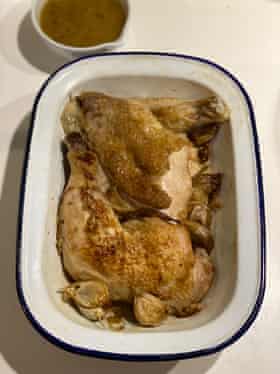
Joyce Goldstein writes in her 1999 book The Mediterranean Kitchen that, “traditionally, this dish is made with a whole roast chicken, baked in a sealed casserole with the garlic cloves and a bouquet garni”. However, Beard published a later recipe for a fricassee, and most more recent versions follow his example, with Goldstein explaining that a whole bird would present “portioning problems” in her restaurant (San Francisco’s legendary Square One).
Chicken pieces do cook more quickly than whole birds, and also do so more evenly, as Cook’s Illustrated’s New Best Recipe Book points out, plus choosing them also means you can choose your own favourite cut. They’re thus perhaps the more sensible choice, but it’s said Beard loved the recipe for its theatricality, often demonstrating it on television for that reason, and, to me, that points towards the whole birds used by Caroline Craig in Provence: The Cookbook and Catherine Phipps’ book Chicken. (If you’re feeding a crowd, or fussy eaters, by all means use chicken joints instead, but you will, in my opinion, miss out on some of the pleasure.)
Like Phipps, I’m going to pot roast the chicken to infuse it with garlicky flavour, and to stop the garlic itself from drying out in the heat of the oven, so a brief preliminary sizzle in a hot pan will help offset its inevitable pallor, making it worth the faff of wrestling with a whole bird over a hot stove. Cooks Illustrated brines its chicken pieces briefly before roasting, claiming that it renders the meat “firm, juicy and well seasoned”, but as long as you don’t overcook the bird, it shouldn’t require it.
(Note that the 1980s American classic The Silver Palate Cookbook makes this recipe with duck. I haven’t tried it, so I can’t say whether it’s an improvement.)
The garlic

This aspect of things is not, to my mind, afforded sufficient importance in most recipes. It seems likely that this dish was probably originally intended to be made with the fresh spring garlic Craig describes as melting into “ludicrously soft and sweet little parcels” under the bird – Anne Willan notes that “the younger the garlic, the milder the sauce will be”. And David quotes Paul-Louis Couchoud that, for success, one requires “heads of garlic from Provence, which have matured quickly and so have not had the time to become too impregnated with their special aroma”. (Indeed, with the right garlic, you could even add 100 cloves, as Helen Rosner boldly claims, and not be overwhelmed, except perhaps by the embarrassment of riches.)
Fortunately, large heads of fresh garlic aren’t hard to come by in early summer, and are certainly the best choice for a dish that, despite its fearsome name, is one of surprisingly gentle, mellow sweetness. However, it’s too good to save for a few short months, so if you can’t find wet garlic, look for large heads with fewer, more generously proportioned cloves, rather than the small, tightly packed heads that seem to be more common in supermarkets. Not only do I find the latter often have a stronger, more piquant flavour that is not ideal for this dish, but such meanly sized examples will wither during cooking, leaving little or nothing for your sauce. Farmers’ markets, greengrocers or continental specialists are good places to look. (If you do find yourself with a few Lilliputian cloves, it’s best to copy Phipps and pierce them with a knife, so their flavour can perfume the dish, even if their flesh does not.)
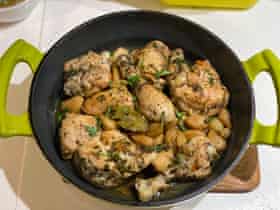
My esteemed predecessor in these pages, Richard Ehrlich, warns that, though there’s disagreement over whether or not to peel the garlic before use, one should not do so “under any circumstances”. Left intact, he says, the flesh will be “steamed and stewed inside [the] husks” to soft, mild perfection – “the best part of the dish”. Puzzlingly, though Beard’s original recipe keeps the peel on, the one published on his website removes it, as does Goldstein, who saves time by simmering the cloves in oil before adding them to the chicken, which means that, though deliciously gooey and rich, they don’t get much of a chance to mingle with the meat and sauce. The same goes for the Cook’s Illustrated garlic, which is baked separately, then added to the pan at the last minute, apparently because they find the stuff in the traditional recipe “spiritless”.
I respectfully disagree, preferring to cook the garlic with the chicken, so the two can commune in the pot, then squeeze the soft, pulpy flesh into the chicken juices to make a sauce, as in Phipps’ version. That said, I love the texture of the slow-cooked cloves, which, as Couchoud says, should be “as tender and sweet as new potatoes”, so I’m going to keep some whole to enjoy as a vegetable accompaniment to my garlic-flavoured chicken in garlic sauce.
Aromatics
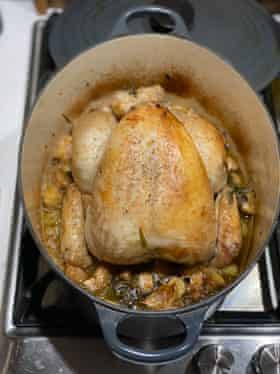
Most people eschew other vegetables, preferring to let the garlic do the talking, but Beard bakes the bird on a bed of onion and celery, while Cooks Illustrated adds shallots, which it says make the sauce “fuller and rounder”. All these things work well with the chicken, but they’re certainly not necessary for a great-tasting result.
The same goes for the herbs that most pop in the pot – sage, rosemary, bay, marjoram, oregano, parsley and tarragon are all attractive possibilities, but, for me, the citrussy, slightly peppery flavour of thyme is the best choice. Do as you wish, however; it’s hard to go wrong with any of the above.
Interestingly, Beard also adds grated nutmeg. Though, instinctively, this doesn’t seem a marriage made in heaven, it actually works very well with the creamy sweetness of the slow-cooked garlic – again, however, this is very much an optional extra.
The sauce

What pot-roasted chicken may lack in crisp, golden skin, it more than makes up for with gravy. A splash of white wine or dry vermouth is a good base, diluted either with water, or, for a richer, more restaurant-like result, chicken stock to give your bird a helping hand.
Phipps suggests finishing the sauce with single cream, and Cooks Illustrated with a knob of butter, both of which are, of course, delicious, especially if you want a more intensely flavoured dish. For a thinner, more rustic gravy, however, just leave things be.
Serve with something to soak up all those delicious juices – good bread, new potatoes or rice all spring to mind, with an undressed green salad on the side.
Perfect chicken with 40 cloves of garlic
Prep 30 min
Cook 1 hr
Serves 4
4 large heads of garlic (wet or standard)
1 tbsp olive oil
1 chicken (about 1½kg)
Salt and pepper (or grated nutmeg)
4 sprigs fresh thyme
250ml dry vermouth (or white wine)
250ml chicken stock (or water)
Heat the oven to 200C (180C fan)/390F/gas 6. Separate the garlic into individual cloves, discarding the papery outer layer, but otherwise leaving them unpeeled.
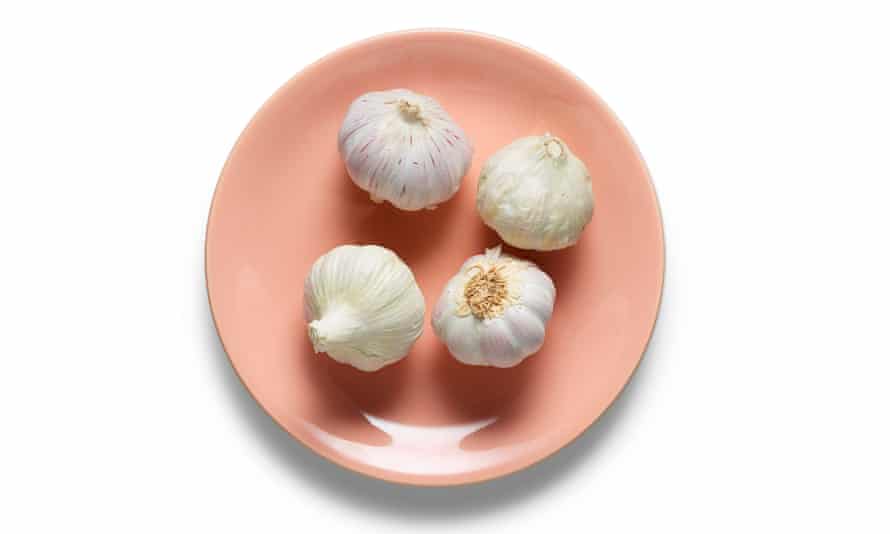
Pierce any very small cloves with a sharp knife, then set the lot aside for the time being.
Grease a casserole dish that’s a little bigger than the chicken itself with olive oil, then put on a high heat.

Season the chicken, then brown it on all sides as best as you can (tongs are useful here), lift it out and set aside, and turn down the heat to medium.
Add the garlic and half the thyme to the pot, toss to coat in the fat, and season. Pour in the vermouth (or wine) and stock (or water), then put the chicken on top; put any small garlic cloves, plus the remaining thyme, into the bird’s cavity first.
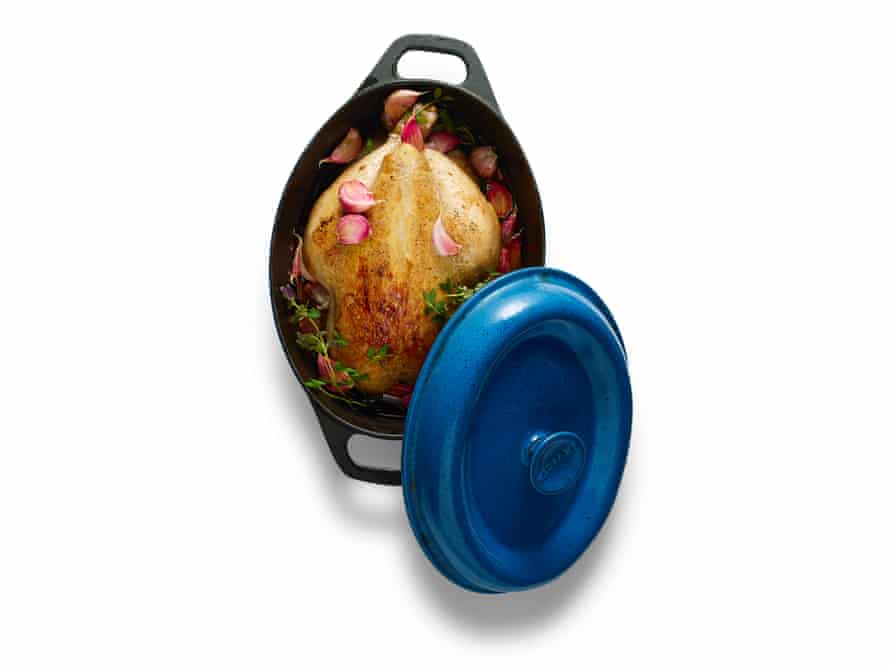
Bring the liquid to a simmer, cover the pot and put in the oven for about 45 minutes.
Take off the lid and roast the chicken uncovered for another 15 minutes, to help brown the skin slightly, then check to see if it’s cooked through - the juices should run clear from the thickest part of the thigh. If not, return to the oven for a few minutes more.
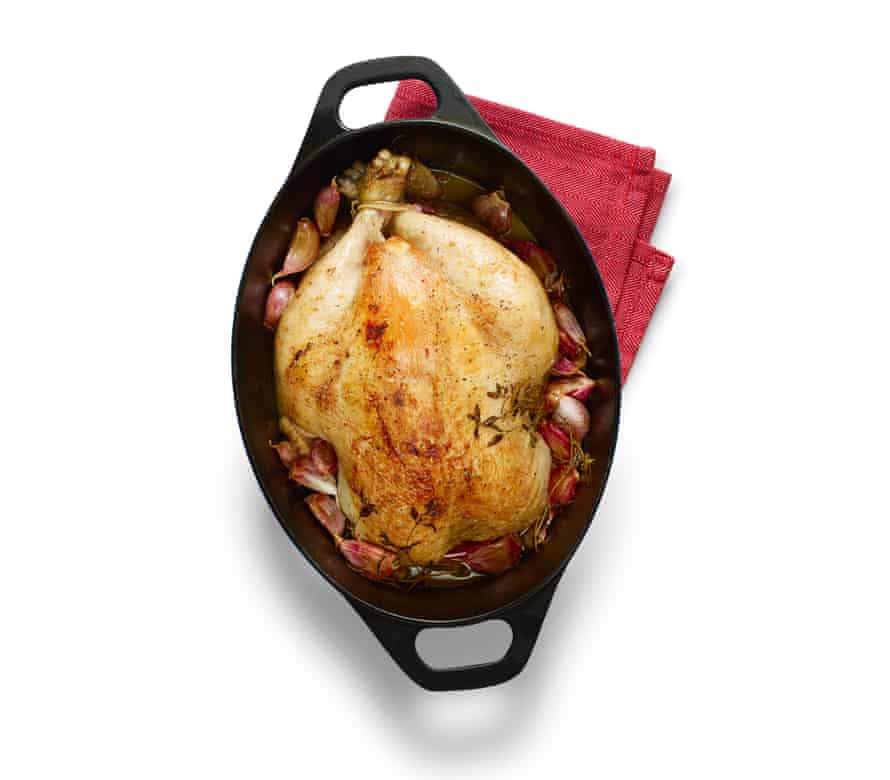
Once the chicken is ready, lift it out of the pot and put it in a warm place to rest.
Meanwhile, scoop out the garlic cloves from the sauce with a slotted spoon and set aside to cool slightly. Return the pot to the hob, bring up to a simmer, then bubble until the liquid has reduced by about a third.
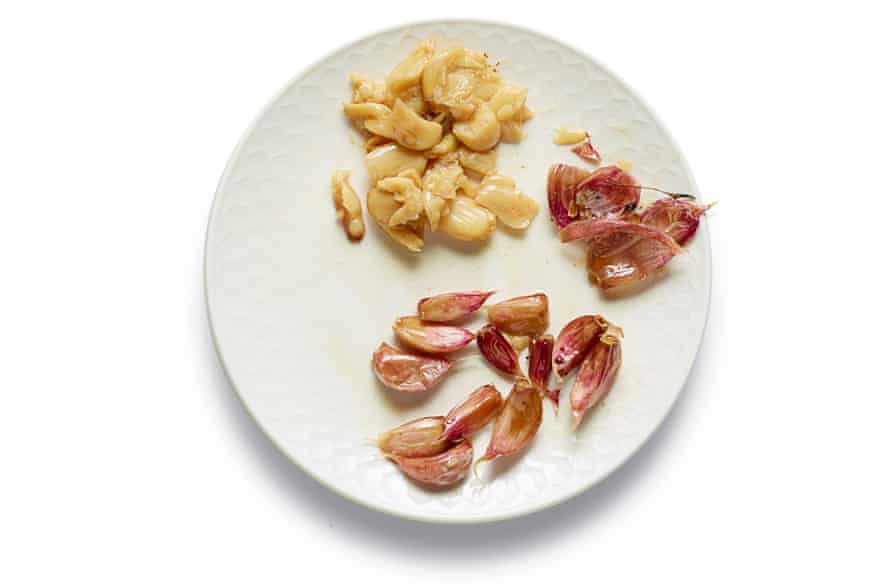
Carefully squeeze out the garlic cloves from their skins and set about half of the plumpest, most handsome ones aside. Mash the rest of the garlic into the sauce, taste for seasoning and adjust as necessary.
Transfer the chicken to a platter, surround it with the reserved whole cloves of garlic and serve with the sauce on the side.
Chicken with 40 cloves of garlic – is 40 enough, or does the very thought make you shudder? Do you have fond memories of the French version, or remember the dish’s heyday over here? And which other mid-century favourites deserve a revival?
from Lifestyle | The Guardian https://ift.tt/2Sw4Vxr
via IFTTT

comment 0 Comment
more_vert